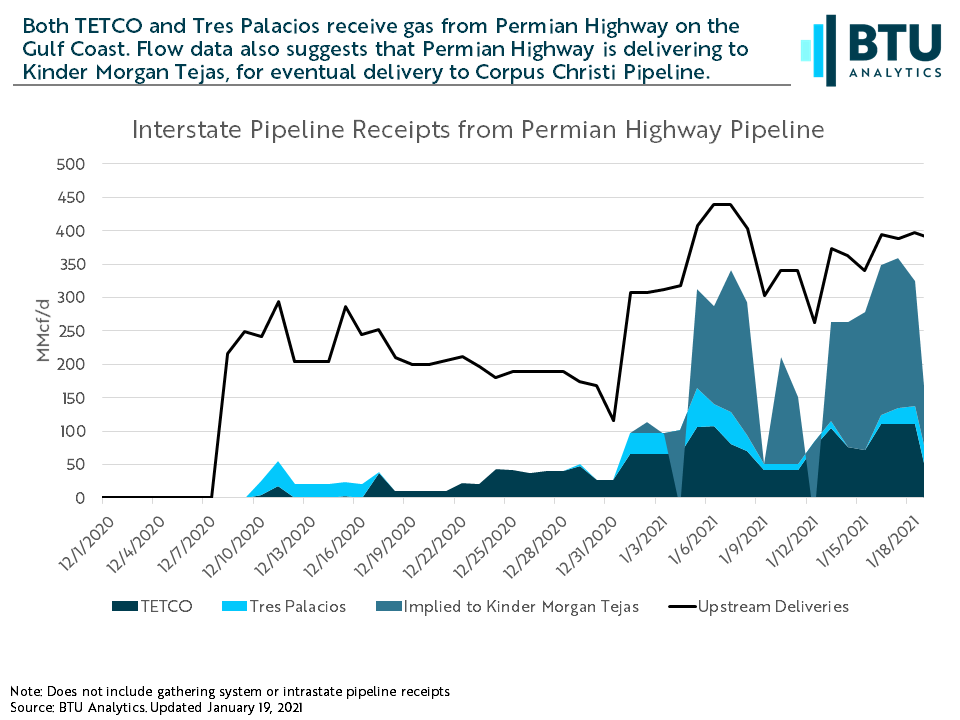Kinder Morgan’s Permian Highway Pipeline entered full service on January 1 after beginning line-fill operations in mid-December. The addition of 2.10 Bcf/d of new pipeline capacity bolstered expectations for Waha basis this month. As a result, the January 2021 Waha futures contract settled at a $0.05/MMBtu premium to Henry Hub Waha. While cash market pricing has not reflected the full level of enthusiasm as the future’s market close, Waha cash prices have narrowed to just ($0.10)/MMBtu below Henry Hub. The tightest spread since January 2016. Today’s Energy Market Insight will take a closer look at the upstream and downstream impacts of Permian Highway in its first two weeks of service.
As with other intrastate pipelines in Texas, like Gulf Coast Express, visibility into flow data on Permian Highway is limited to its interconnections with interstate pipelines. As of writing, five interstate pipelines are posting flows at interconnects with Permian Highway. Upstream, El Paso, NNG, and Transwestern combine to deliver 370 MMcf/d to Permian Highway. Most of these volumes appear to be displaced flows from the Westbound and Northbound corridors out of the Permian. Westbound and Northbound flows have fallen 230 MMcf/d relative to December 31, shown in the red line below.

Downstream, Permian Highway is delivering to two interstate pipelines, TETCO and Tres Palacios, along the Texas Gulf Coast. Visible downstream deliveries are lower than upstream receipts indicating that Permian Highway is likely also delivering the remaining volumes to intrastate pipelines. Though volumes are not publicly available on intrastate pipelines, looking deeper at interstate flow data we find evidence Permian Highway is also delivering downstream to Kinder Morgan Tejas. After Permian Highway entered service, deliveries from Kinder Morgan Tejas (an intrastate) to Corpus Christi Pipeline (an interstate) increased by 160 MMcf/d. Given the timing, it is likely that Permian Highway is delivering those incremental volumes to Kinder Morgan Tejas for eventual delivery to Corpus Christi. At the same time, deliveries to Corpus Christi from Tennessee Gas and Transco have fallen by the same amount.

Since Permian Highway is an intrastate pipeline, it is difficult to ascertain inflow data if the pipeline is highly utilized, but Waha pricing can shed light on flow dynamics. Waha pricing is linked to the utilization of the Eastbound corridor from the Permian, which connects the basin to premium Gulf Coast markets. When Gulf Coast Express came online in late 2019, only a small subset of flows out of the pipeline’s 1.92 Bcf/d of capacity was visible, but it was clear from weak pricing at Waha that Gulf Coast Express flows increased to its full capacity quickly. If Gulf Coast Express had come online and filled slowly, leaving some open capacity Eastbound from the Permian, Waha pricing would have strengthened after it entered service and only weakened out again once the pipe reached high utilization. As shown in the chart below, which shows Waha outright price indexed to the day before each pipeline entered service, Waha actually weakened after Gulf Coast Express came online, indicating that Gulf Coast Express filled to capacity quickly.

The opposite has been true so far for Permian Highway – in the two weeks since it entered full service, Waha has strengthened by about 10% relative to December 31. Persistent strength at Waha indicates that there is open capacity on the Eastbound corridor. While it is not an absolute that this open capacity is physically on Permian Highway, the addition of 2.1 Bcf/d of capacity leads to open capacity across the Eastbound corridor. With crude prices escalating, Waha pricing may not retain the strength observed in January for long. For more on the outlook for Waha basis and impacts of higher crude oil pricing on associated gas production growth, request a sample of our Gas Basis Outlook.









